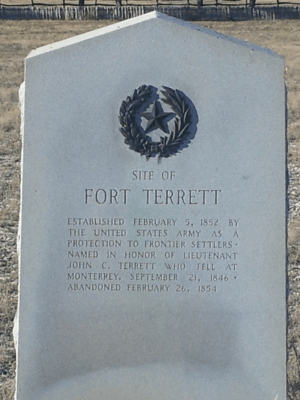Fort Terrett, Texas facts for kids
Quick facts for kids Site of Fort Terrett |
|
|---|---|

Fort Terrett Historical Marker
|
|
| Location | CR 307 off IH-10 via Exit 429 near Sonora, Texas |
| Built | 1852 |
| Governing body | Private |
|
Recorded Texas Historic Landmark
|
|
| Designated | 1962 |
| Reference no. | 4799 |
| Lua error in Module:Location_map at line 420: attempt to index field 'wikibase' (a nil value). | |
Fort Terrett was a U.S. Army post in Sutton County, Texas. It was active from 1852 to 1854. Later, the site became part of a ranch. Today, it is an important historical place in Texas.
Contents
Fort Terrett: A Frontier Outpost
Fort Terrett was first called "Post on the Rio Llano" or "Camp Lugubre." In 1852, it was renamed after Lieutenant John Terrett. He was a brave soldier who died in the Battle of Monterrey in 1846.
Why Was Fort Terrett Built?
Lieutenant Colonel Henry Bainbridge set up the fort in February 1852. Its main job was to protect settlers and travelers. These people were moving along the Upper San Antonio Road. The fort was located along the North Llano River in Sutton County.
Life at the Fort
Soldiers at Fort Terrett helped keep the peace on the frontier. They protected people from dangers and helped new settlements grow. Life at a frontier fort was often tough and isolated.
The Fort's Later Years
The U.S. Army abandoned Fort Terrett in February 1854. The soldiers moved further west and north as the frontier expanded. After the army left, the fort buildings were used as part of the Terrett Ranch.
Even after the fort was officially closed, the area remained important. In 1875, Major John B. Jones led a group of Texas Rangers and local people. They were searching the area near the old fort. They were looking for groups causing trouble and disturbing the peace. Major Jones and his Rangers worked to keep the frontier safe for everyone.
Remembering Fort Terrett Today
The state of Texas has placed a special marker at the site. This marker helps people remember Fort Terrett's history. You can find it off CR 307 near I-10, Exit 429.
Images for kids


